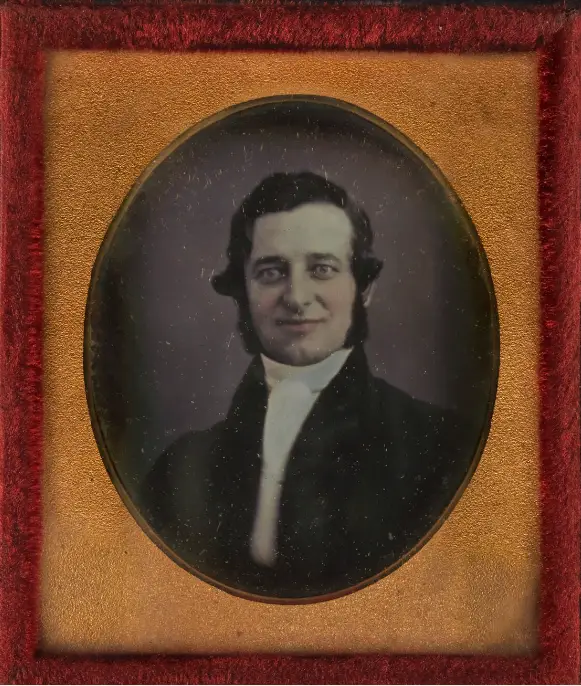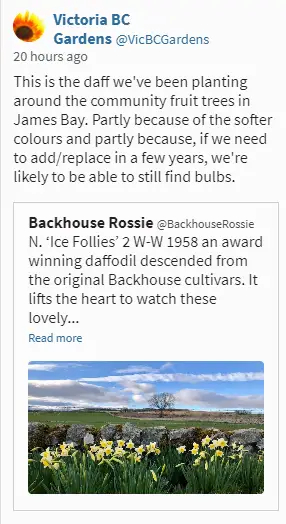Lloyd was the 2nd cousin 2x removed of William Backhouse
The tweet below caught our eye! Here, in James Bay, Victoria, BC, “Backhouse” daffodils have been planted.
So, the internet search began and yielded the following ….
Sources: The National Collection of Narcissus, Backhouse cultivars
and Botanists and Bankers
Daffodils are often described as the most extensively grown ornamental in the British Isles. Commercially, it is indisputably the most important crop in the United Kingdom, which is the world’s largest producer, accommodating about half the global total area. About 29% of the crop is forced and 28% grown outdoors for flower production. The remaining 43% is grown for dry bulb production, much of which is exported in a trade worth several million pounds a year. In addition, the results of pioneering work in breeding new cultivars have been distributed all over the temperate world, (Dr David Willis ‘Yellow Fever’).
James Backhouse (I) (1721- 1798) really enabled the financial security which allowed his children and their successors to pursue a growing interest in the natural world, botany and horticulture. James (I) successfully founded the Quaker ethical Backhouse Bank in Darlington, Co Durham in 1774 with his two sons Jonathan (I)(1747–1826) and James (II) (1757-1804).
‘The bank became one of the most stable influences in the finance of Northern business, surviving several serious crisis in which many other banks failed’, Raistrick (1968).
In 1896, Backhouse and Co, Darlington and twenty other private banking firms, joined together to form Barclay and Company Limited in what the banking press at the time referred to as a merger of the ‘well-known Quaker firms’.
The Daffodil Raisers
Johnathan Backhouse (I) (1747–1826), had three sons but William was the most active at the start of the Daffodil dynasty:
William Backhouse (I) (1779-1844), was a botanist of some note, with a plant collection of significance, but it was his son William born in 1807 who was the first of the Backhouse daffodil-breeding dynasty.
William Backhouse (II) (1807–1869), worked in the family bank but his greatest legacy were the daffodils he raised which changed daffodil breeding in this country forever. Among the many cultivars William raised three are of particular importance: N.‘Emperor’ and N.‘Empress’ being two of the first known triploid daffodil cultivars raised in this country (21 chromosomes) and N.‘Weardale Perfection’ the first known tetraploid cultivar (28 chromosomes). Such is the importance of these daffodils, they still form the basis of many daffodils we enjoy in commerce today. So influential was William’s contribution, that the Royal Horticulturalists Society named a section of Daffodils under the Title ‘Section Backhouseii’.
Robert Ormston Backhouse (1854–1940), William’s third son worked in the family bank, was a keen amateur archer and the first in the family to set up a commercial bulb business growing and selling and buying in daffodils commercially. Robert also raised his own daffodil hybrids many of which he registered along with lilies with his wife Sarah Elizabeth Dodgson.
Henry Backhouse (1850–1936), William’s middle son also raised and registered his own new daffodil cultivars, his best known being N.’Niveth’ 5 W-W, N.’Triandrus’ in 1931.
Mrs RO Backhouse – Sarah Elizabeth Dodgson (1857–1921), raised new varieties of Narcissus, Colchicum, Hyacinths, Lilium (The Backhouse hybrids) and Cyclamen. Achieving national fame gaining an award from the Royal Horticultural Society in 1901 for ‘Moonbeam’, an RHS Bronze Flora Medal in 1905 for a ‘Group of Daffodils’ and the Barr Cup in 1916. Mrs RO was particularly known for raising new varieties of red-cupped daffodils, but will always be remembered for her namesake pink daffodil, N.’Mrs RO Backhouse’ 2 W-P, the most well known and widely grown pink daffodil over the last 90 years. Her legacy can also be found in her lilium hybrids including her name sake N.’Mrs R.O Backhouse’.
William Ormston Backhouse (1885–1962), attended Cambridge University and was a trained geneticist, worked at the Cambridge Plant breeding Station, The John Innes Institute then for the Argentine Government where he created an important strain of rust resistant wheat MA38. As a trained geneticist WO Backhouse was well placed to create the first Division 1 red trumpet daffodil which he successfully achieved registering several of these uniquely coloured trumpet daffodils including N.’Brer Fox’, N.’Sutton Court’, N.’Red Curtain’ and N.’Desert Fox’.
Caroline G Thomson MA, direct descendant and 6th generation of the Backhouse horticulturalists. Daffodil Breeder and Collector of her forebears Historic Backhouse Daffodils along with many other Backhouse family plants across several genera. She is bringing her Backhouse family Heritage back to life quite literally at the Backhouse Rossie Heritage & Education Centre #livingheritage at the family home, Rossie Estate.
The Plant finders, Nursery & Seedsmen
James Backhouse (II) (1757-1804) of Banking fame, had two sons James & Thomas:
James Backhouse (III) (1794-1869), Minister The Religious Society of Friends, Quaker Missionary and Botanist. With his brother Thomas in 1815 they bought the well respected J and G Telford Nursery in Tanner Row, York which became the original site of Thomas and James Backhouse Nursery and Seedsmen, their first catalogue was published in 1816. In 1824 James was admitted as a minister in the Religious Society of Friends and on the 3rd September 1831 he departed for Australia on humanitarian work, He returned home 10 years later, via Mauritius and South Africa. During his travels in Australia he made detailed observations of the plants and trees he thought unusual, collecting seeds, plants and specimens sending them home to his brother Thomas. In 1845 in the European science publication the Botanical Magazine, William Jackson Hooker (Director at Kew) and William Henry Harvey first published Backhousia as a genus of thirteen currently known species of flowering plants in the family Myrtaceae, after botanist James Backhouse. Today you can enjoy Backhouse citriodora or Lemon Myrtle in our biscuits and tea at the Backhouse Cafe.
Thomas Backhouse (1792-1845), Businessman, entrepreneur and Nurseryman, Thomas bought J and G Telford’s Nursery in York, with brother James Backhouse. In 1815, he joined his younger brother, James two years later when his business interests in Darlington were consolidated, When his brother went abroad for 10 years, Thomas raised James’ children and managed and developed the nursery by himself, with the coming of the railway he moved the Nursery to Fishergate York.
The Backhouse brothers showed their ability to compete with London when, in 1819, they put an advertisement in the Yorkshire Gazette for ‘Choice BULBS of BELLA-DONNA and GUERNSEY LILIES’.
James Backhouse (IV) (1825-90), Nurseryman, botanist, plant collector, archaeologist, geologist. The Nursery became recognised around the world for their rock work, alpine plants, heathers, ferns, orchids, nerines. After his father James’s return the Nursery moved again in 1853 to a 100-acre site at Holgate, renamed after Thomas’s death, James Backhouse and Son.
James Backhouse (V) (1861-1945), renowned as a naturalist and especially for his knowledge of ornithology, authour, formed a new company in 1891, Backhouse Nurseries (York) Ltd. The Holgate Nursery closed in 1955, a small part is owned by the Council, which remains in use as the West Bank Park.
The Tree Planters
Johnathan Backhouse (I) (1747–1826), started tree planting on his estates in County Durham, this work was continued by three of his four sons:
William Backhouse (I) (1779-1844), was awarded a Society of Arts Medal for tree planting. Gold Medal 1813 for planting 300,000 Larch trees, 50,000 Scots Pine, Oak and other trees on his estate. He was awarded the premium award in Class 10 for planting the most larch trees (used to build ships).
Jonathan Backhouse (II) (1779-1842), was awarded a Society of Arts medal for tree planting, a great supporter of the Stockton & Darlington Railway.
Edward Backhouse (1781-1860), was awarded a Society of Arts medal for tree planting and founder of the Backhouse Bank in Sunderland.
Caroline’s mother Lady Georgina Buchan-Hepburn, a direct descendant of the Backhouse family, was the first to raise her conservation concerns that the family’s horticultural legacy was being lost to time. Sadly one victim was our family’s Backhouse Nursery which was put under the bulldozer for a park and little of the original features or plants exist today. This heartfelt concern has been the start of a lifetimes’ work collecting, safe guarding and growing in focused collections both the historic daffodils and the many other plant introductions of the botanizing Backhouses across several genera. Fortunately some of our forebear’s plants have been preserved by the extended family and these have been brought together at Rossie Estate into a focused collection, along with family ephemera on display at the Backhouse Rossie Heritage and Education Centre. For over ten years a conservation programme to create suitable environments, observe document and record, the collection. The collection continues to increase with kind donations of bulbs, which are under review. The daffodils were awarded National Plant Collection status by Plant Heritage in late 2016. RHS Wisley have requested herbarium specimens for their archive to provide a benchmark for posterity.
“In a race against time, Caroline contacted family members, private growers, the RHS and other horticultural organisations around the world to help collect missing plants and identify others.”
Currently the Collection, based at Rossie Estate in Fife, comprises over 89 Backhouse Heritage Daffodil cultivars – the largest collection of Backhouse heritage daffodils in the world.
Looking forward, Caroline hopes to continue the family tradition by registering new hybrids #livingheritage.
We are delighted to announce that from January 2017 Backhouse Rossie has been part of the RHS Partner Garden scheme. In 2016, we underwent an assessment for the Partner Garden Scheme and we are thrilled to be accepted thereafter.
From the Guardian
In spring, the most assertive garden escapers are daffodils, dotted among the butterbur and ground elder leaves. It’s more than likely that some are descendants of bulbs bred in the mid-19th century by William Backhouse, who hybridised them in the grounds of his austere country house high above Wolsingham, among conifer plantations and windswept moorland at St Johns, on the edge of Pikestone Fell.
Backhouse’s masterpiece was “Weardale Perfection”, a famously robust, late-flowering Narcissus with tall stems and large blooms, composed of an ivory white perianth and outsized lemon yellow trumpet. Tastes have changed, but in Backhouse’s day it was a horticultural sensation. We found it in Wolsingham parish churchyard, planted in 2007 after being propagated from a bulb found in the garden of Jesse Young, the local district nurse. This afternoon its trumpets were in full bloom, comfortably upright in a blustery April wind that had flattened more refined, weaker-stemmed modern cultivars in gardens.
Backhouse died in 1869, without ever seeing his finest daffodil bloom. Its qualities were recognised by his son, who named it. For as long as its trumpets deliver their annual fanfare of colour among the headstones of past generations of parishioners, they will give its creator a special kind of immortality.

